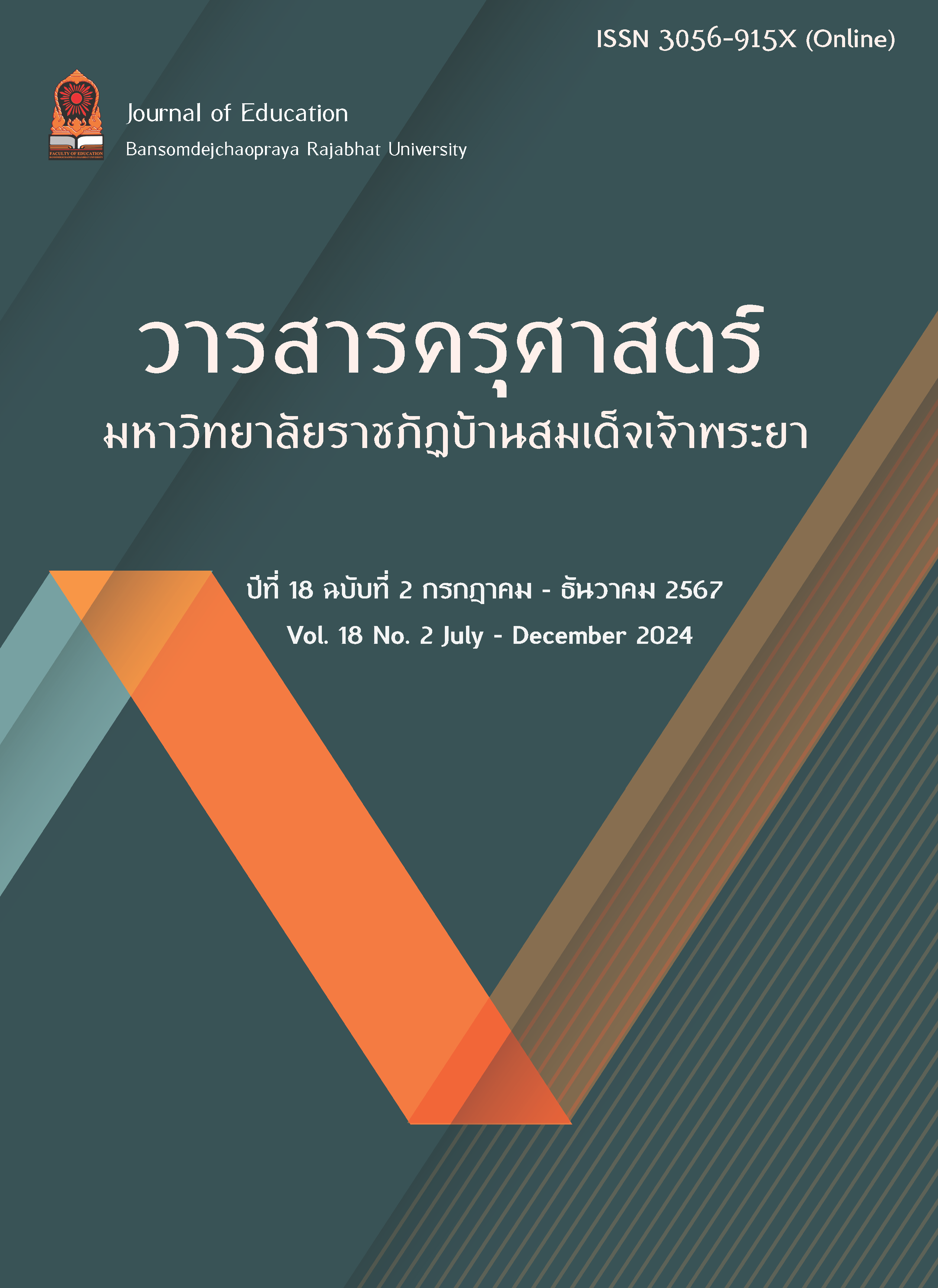การพัฒนาบทเรียนเชิงกิจกรรม เรื่อง ชิ้นส่วนอิเล็กทรอนิกส์เบื้องต้น ผ่านทฤษฎีการเรียนรู้เชิงประสบการณ์
คำสำคัญ:
บทเรียนเชิงกิจกรรม, ชิ้นส่วนอิเล็กทรอนิกส์เบื้องต้น, ทฤษฎีการเรียนรู้เชิงประสบการณ์บทคัดย่อ
การวิจัยนี้มีวัตถุประสงค์เพื่อ 1) พัฒนาและหาประสิทธิภาพบทเรียนเชิงกิจกรรม เรื่อง ชิ้นส่วนอิเล็กทรอนิกส์เบื้องต้น ผ่านทฤษฎีการเรียนรู้เชิงประสบการณ์ ให้มีประสิทธิภาพตามเกณฑ์ 80/80 และ 2) เปรียบเทียบผลสัมฤทธิ์ทางการเรียนระหว่างก่อนเรียนกับหลังเรียนด้วยบทเรียนเชิงกิจกรรม ประชากร ได้แก่ นักเรียนระดับชั้นมัธยมศึกษาปีที่ 3 จากกลุ่มโรงเรียนสังกัดสำนักการศึกษากรุงเทพมหานคร ที่สมัครเข้าร่วมการวิจัยโดยความสมัครใจ กลุ่มตัวอย่างถูกเลือกมาจากประชากรผ่านการเปิดรับสมัครนักเรียนเข้าร่วมโครงการวิจัย ซึ่งเป็นการสอนนอกเหนือเวลาเรียนตามปกติ โดยมีนักเรียนเข้าร่วมเป็นจำนวนทั้งสิ้น 62 คน เครื่องมือที่ใช้ในการวิจัย ประกอบด้วย 1) บทเรียนเชิงกิจกรรม เรื่อง ชิ้นส่วนอิเล็กทรอนิกส์เบื้องต้น ซึ่งมีจำนวน 5 ตอน ได้แก่ ตอนที่ 1 อะไรอยู่ในเครื่องใช้ไฟฟ้า ตอนที่ 2 ตัวต้านทานคืออะไร ตอนที่ 3 ไดโอดคืออะไร ตอนที่ 4 LED คืออะไร และ ตอนที่ 5 อะไรอยู่ในกล่องปริศนา และ 2) แบบทดสอบวัดผลสัมฤทธิ์ทางการเรียน การวิเคราะห์ข้อมูลและสถิติที่ใช้ ประกอบด้วย ค่าเฉลี่ยเลขคณิต ส่วนเบี่ยงเบนมาตรฐาน และการทดสอบทีแบบกลุ่มตัวอย่างไม่เป็นอิสระต่อกัน
ผลการวิจัยพบว่า 1) บทเรียนเชิงกิจกรรม เรื่อง ชิ้นส่วนอิเล็กทรอนิกส์เบื้องต้น ผ่านทฤษฎีการเรียนรู้เชิงประสบการณ์ มีประสิทธิภาพ 86.52/82.63 เป็นไปตามเกณฑ์มาตรฐาน และ 2) ผลสัมฤทธิ์ทางการเรียนหลังเรียนสูงกว่าก่อนเรียนอย่างมีนัยสำคัญทางสถิติที่ระดับ .05 การวิจัยนี้ชี้ให้เห็นว่าการเรียนรู้เชิงกิจกรรมที่ผสานทฤษฎีการเรียนรู้เชิงประสบการณ์สามารถช่วยให้นักเรียนมีความเข้าใจเกี่ยวกับชิ้นส่วนอิเล็กทรอนิกส์ที่ลึกซึ้งยิ่งขึ้น อันจะมีประโยชน์ในแง่ของการพัฒนาทักษะการคิดวิเคราะห์ที่จำเป็นต่อการเรียนรู้ในระดับที่สูงขึ้นหรือการบูรณาการความรู้ในมิติที่หลากหลายมากขึ้น อาทิเช่น สะเต็มศึกษา
Downloads
เอกสารอ้างอิง
Rachel Cohen, Bat-Sheva Eylon, and Uri Ganiel. (1983). Potential difference and current in simple electric circuits: A study of students’ concepts. American Journal of Physics, 12(51), 407–412.
Shipstone David. (1988). Pupils' understanding of simple electrical circuits. Some implications for instruction. Journal of Physics Education, 7(23), 92.
Masahiro Kamata and Mayum Abe. (2012). Hand-drawn resistors and a simple tester using a light-emitting diode. Journal of Physics Education, 11(47), 741.
Gorazd Planinšič and Etkina Eugenia. (2014). Light-emitting diodes: A hidden treasure. Journal of The Physics Teacher, 10(52), 94–99.
Etkina Eugenia and Gorazd Planinšič. (2014). Light-emitting diodes: Exploration of underlying Physics. Journal of The Physics Teacher, 10(52), 212–218.
Irwandi Irwandi, Rini Oktavia, Rajibussalim Rajibussalim, and Halim Melvina Si. (2018). Light emitting diode (LED) as an essential prop component for STEM education in the 21st century: A focus for secondary school level. Journal of Physics: Conference Series, 1088, 012060.
Radhika Menon, Aadityan Sridharan, Surya Sankar, Georg Gutjahr, Vani Chithra, and Prema Nedungadi. (2021). Transforming attitudes to science in rural India through activity based learning. AIP Conference Proceedings, 2336, 040003.
Serpil Kara and Oktay Aslan. (2023). Evaluation of the effect of in-class activity-based practices on scientific reasoning skills of pre-service science teachers. International Journal of Science Education, 45(7), 1–22.
Valarie Akerson, Fouad Abd-El-Khalick, and Norman Lederman. (2000). Influence of a reflective explicit activity-based approach on elementary teachers' conceptions of nature of science. Journal of Research in Science Teaching, 37(12), 295–317.
David Kolb. (1984). Experiential learning: Experience as the source of learning and development. Journal of Englewood Cliffs, NJ: Prentice-Hill, 12(4), 123-128.
John Dewey. (1897). My pedagogic creed. The School Journal, 54(5), 77–80.
Jean Piaget. (1952). The origins of intelligence in children: New York : International Universities Press.
Patricia Murrell and Charles Claxton. (1987). Experiential learning theory as a guide for effective teaching. Journal of Counselor Education and Supervision, 27(6), 4–14.
Thomas Morris. (2020). Experiential learning – a systematic review and revision of Kolb’s model. Journal of Interactive Learning Environments, 28(8), 1064–1077.
ดาวน์โหลด
เผยแพร่แล้ว
รูปแบบการอ้างอิง
ฉบับ
ประเภทบทความ
สัญญาอนุญาต
ลิขสิทธิ์ (c) 2024 คณะครุศาสตร์ มหาวิทยาลัยราชภัฏบ้านสมเด็จเจ้าพระยา

อนุญาตภายใต้เงื่อนไข Creative Commons Attribution-NonCommercial-NoDerivatives 4.0 International License.
บทความที่ได้รับการตีพิมพ์เป็นลิขสิทธิ์ของคณะครุศาสตร์ มหาวิทยาลัยราชภัฏบ้านสมเด็จเจ้าพระยา
ข้อความที่ปรากฏในบทความแต่ละเรื่องในวารสารวิชาการเล่มนี้เป็นความคิดเห็นส่วนตัวของผู้เขียนแต่ละท่านไม่เกี่ยวข้องกับมหาวิทยาลัยราชภัฏบ้านสมเด็จเจ้าพระยา และคณาจารย์ท่านอื่นๆในมหาวิทยาลัยฯ แต่อย่างใด ความรับผิดชอบองค์ประกอบทั้งหมดของบทความแต่ละเรื่องเป็นของผู้เขียนแต่ละท่าน หากมีความผิดพลาดใดๆ ผู้เขียนแต่ละท่านจะรับผิดชอบบทความของตนเอง



